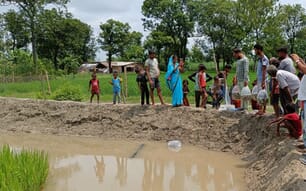A Purdue University study shows that Asian carp are spawning in waters generally thought too narrow or slow moving. And while spawning was thought to end sometime in July, researchers have found evidence of fish spawning far upstream and eggs drifting in water as late as September in the Wabash River in Indiana.
"It looks like the carp can probably become established in a wider range of environmental conditions than once thought," said Reuben Goforth, an assistant professor of forestry and natural resources. "While the presence of eggs indicates successful spawning by these fishes in new areas, it's not known yet whether those eggs would be successful in surviving to adulthood."
Silver carp, black carp, grass carp and bighead carp - known collectively as Asian carp - are spreading throughout Midwest rivers. These invasive species may be outcompeting native species that are commercially and recreationally desirable. The fish can weigh up to 60 pounds, and silver carp jump out of water when disturbed, sometimes causing injuries to boaters and others using rivers and streams.
While conservation workers and scientists are working hard to contain Asian carp, there is still concern that they could spread to other tributaries if they get into the Great Lakes.
Models used to predict where and when Asian carp might spawn have been heavily based on information gathered from native habitats in Asian rivers and streams. But Goforth said there is strong evidence that the carp are able to reproduce in waters and conditions that were not expected.
"The reason truly invasive species are so successful is because they overcome obstacles," Goforth said. "When you base their limitations on what happens in their native ecosystems, it's a good start. But it may be a good idea to go back and take this new data to recalculate more precise limits based on these new understandings."
Goforth said it had been believed that heavier spring rain that increased water depth and flow in rivers was necessary for successful spawning. But last year's severe drought limited stream flows, and Asian carp eggs were found in shallow and narrow portions of the Wabash River once thought incapable of supporting the species.
"We didn't have the normal spring floods and they spawned anyway," Goforth said. "Those changes in water flow and depth might be a cue to spawn, but they're not something that's absolutely necessary."
Goforth said his laboratory would work on determining what allows Asian carp to adapt to conditions unlike those in their native habitats.
"What we don't know is whether they have the ability to acclimate to those conditions or whether there is a sort of micro-evolution going on that allows them to adapt to these conditions," he said.
The Indiana Department of Natural Resources and the US Geological Survey's Upper Midwest Environmental Sciences Center collaborated with Purdue researchers. Their findings were published in the journal Freshwater Biology.
The Indiana DNR, U.S. Environmental Protection Agency and Great Lakes Restoration Initiative funded the research.



